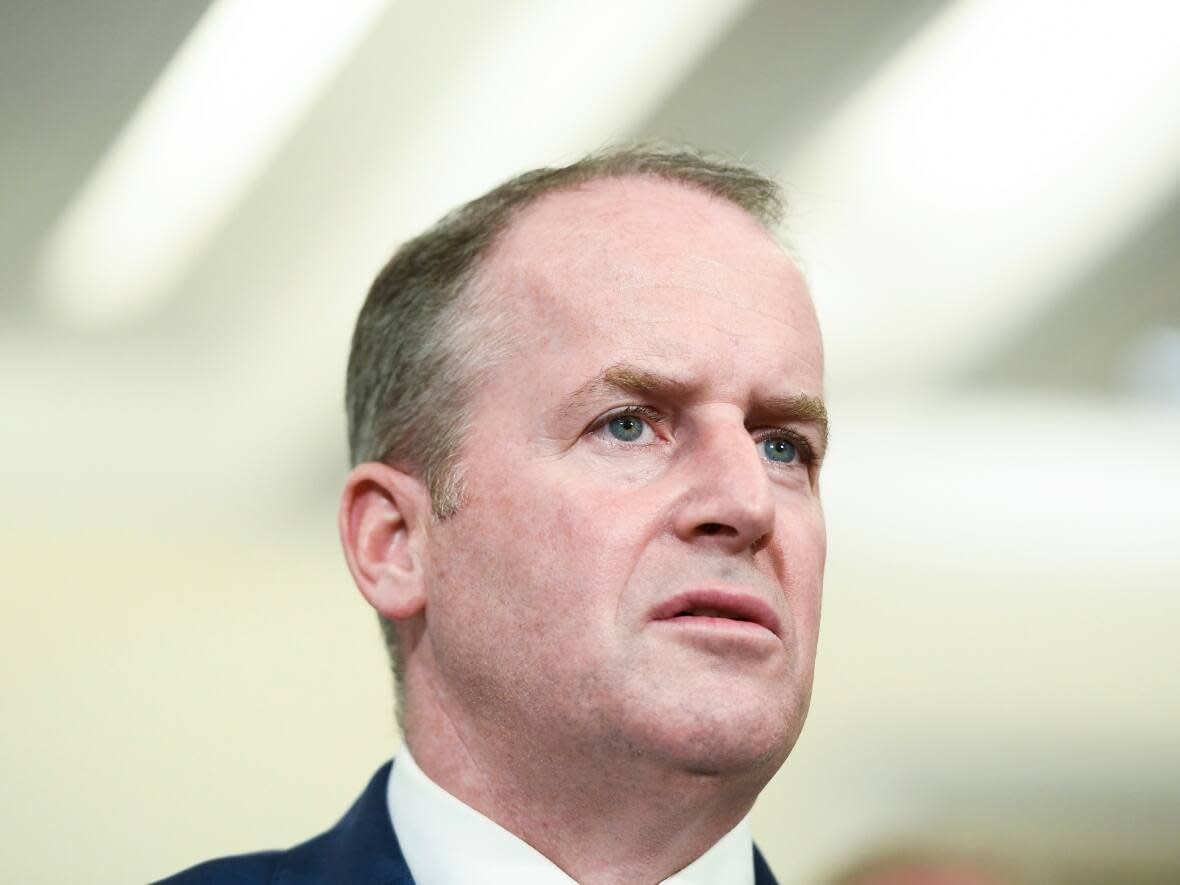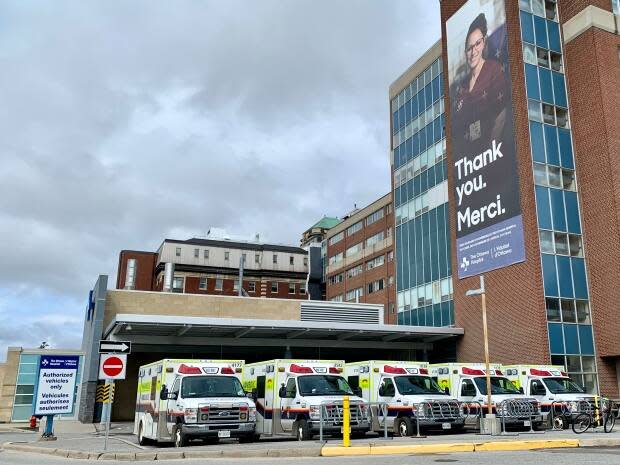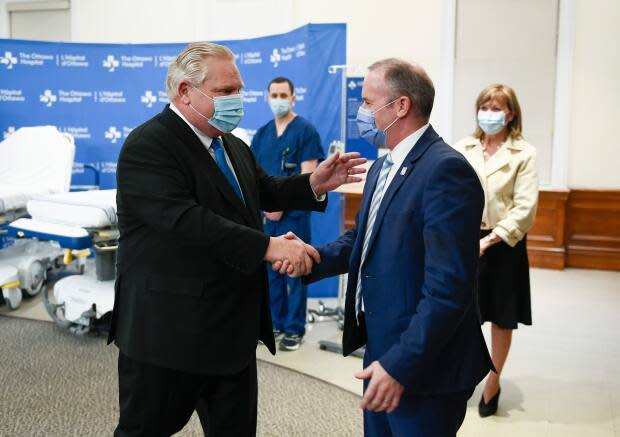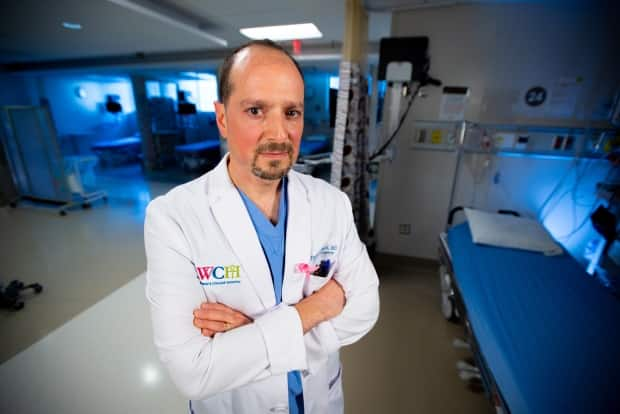Joint surgery partnership 'just the beginning,' The Ottawa Hospital vows

The president and CEO of The Ottawa Hospital (TOH) says a pilot project involving a private group of orthopedic surgeons who have been performing joint replacements at the Riverside campus on Saturdays has proved so successful they could soon move to their own separate facility — and the same model could soon be applied to other areas of medicine including gynecology, urology and plastic surgery.
On Wednesday, TOH issued a statement lauding its recent partnership with Academic Orthopedic Surgical Associates of Ottawa Inc. (AOAO). The group, which was incorporated in December 2021, is made up of 26 orthopedic surgeons who practise at the hospital.
According to the statement, AOAO has performed 40 hip and knee replacements over the past four Saturdays at the Riverside, where operating rooms normally sit empty on weekends. Adding that extra capacity has amounted to "a 20 per cent increase in surgical productivity for the hospital," TOH said.
While the arrangement has come under fire from some physicians, unions and public health-care advocates, the hospital has clearly signalled it's not about to reverse course.
"This partnership is just the beginning, as we look to create more models of care that ensure all patients receive the care they need," the hospital said.

Ready for '2nd phase'
In an interview with CBC on Wednesday, TOH president and CEO Cameron Love said the hospital is preparing to take its partnership with AOAO to the next level, and confirmed that will likely involve moving to a new out-patient facility somewhere in the city.
"After four weeks of running [the pilot at the Riverside], what we have now been able to confirm is that the efficiency of that centre is very good, both operationally and productivity-wise, and financially," Love said. "We're able to now start to plan a second phase."
Unlike the current arrangement with AOAO, which uses the hospital's existing surgical space at the Riverside, moving those procedures to a separate facility owned or leased and operated by the corporation would require ministerial approval under the Public Hospitals Act.
It's all publicly funded. There is no private system here. - Cameron Love, president and CEO of The Ottawa Hospital
Love said TOH intends to have its submissions to the ministry prepared by late spring or early summer, and said he expects a wider range of lower-risk procedures to be offered outside the hospital under what he calls a "regionally integrated surgical system," starting with women's health.
"As we start to get our second phase of getting orthopedics planned, women's health will be the next one where we'll be working with our chief of ob-gyn to start to plan how we're going to create capacity for the gynecology service, which is primarily out-patient," Love said.
Urology and plastic surgery could soon follow, he added, creating greater capacity at the hospital for more complex in-patient procedures such as neurosurgery, cancer surgery and vascular surgery.
Similar to cataract surgeries
Love compared the hospital's plan to its arrangement with Focus Eye Centre, where he said 2,000 to 3,000 cataract surgeries are now performed annually at the Carling Avenue clinic, freeing up surgical space for more complex opthalmological procedures.
"This is really around innovating and coming up with new models by which we can transform the health-care system, because under the current model, if we don't start to do that, we are going to have significant issues in terms of access to care," Love said.

The hospital publicly acknowledged its partnership with AOAO last month. The first surgeries at the Riverside were performed Feb. 25.
CBC News has made numerous attempts to contact the surgeons listed as directors of the group, but has had no direct response. Instead, the hospital has intermittently issued statements on the group's behalf.
CBC News had also been requesting an interview with Love since March 3, but was told until Wednesday that he was unavailable.
While some critics of the partnership have expressed concern that it could lure employees away from the hospital at a time when it's critically short-staffed, the hospital said fewer than half of the nurses and other staff working for AOAO on weekends are TOH employees.
AOAO pays registered nurses, registered practical nurses and clerical staff who agree to work Saturdays about double what they'd earn for an eight-hour hospital shift. The hospital has pledged to monitor staffing levels "and adjust accordingly, as needed."
Nor are the surgeries costing any more than they would under the existing framework, according to the hospital: While each knee or hip procedure typically costs TOH $8,000, AOAO is performing them for about $6,400, allowing the hospital to reinvest the remainder in patient care.
Patients won't pay
AOAO's patients are registered with TOH and drawn from a central wait-list, and all procedures are billed through OHIP, the hospital said.
"In no situation does the patient pay for anything. It's all publicly funded. There is no private system here," Love said. "It is within the public system. The ministry funds us, we set up models to create capacity, and pay and provide the oversight."
In February, the province tabled legislation to allow more private clinics to offer certain publicly funded surgeries including hip and knee replacements. The government has pledged those procedures will continue to be covered through OHIP.
CBC News has made repeated requests to speak with Health Minister Sylvia Jones about the partnership between TOH and AOAO, but has been told she's unavailable.
Earlier this month, Ontario NDP Leader Marit Stiles held a news conference outside the Riverside campus, where she characterized the partnership between TOH and AOAO as part of a plan to turn the province's public health-care system in to a "two-tiered, investor-driven private model."
"This is exactly what we were afraid was going to happen, and it's happening right now as we stand here today," Stiles warned.

No need for 'quasi-hospitals'
Some public health-care advocates have questioned why, since the partnership currently relies on existing medical staff and hospital facilities, the surgeries aren't being performed under a more traditional delivery model.
Dr. David Urbach, head of the department of surgery at Women's College Hospital in Toronto and professor of surgery and health policy, management and evaluation at the University of Toronto, said the model being employed in Ottawa suggests they could be.
"I think all this should be signalling to the province that in fact the public hospital system has capacity to do this expansion, and they don't need to look to creating this whole brand new sector of kind of quasi-hospitals that don't yet exist, and that no one is really sure about what the quality of care might be or what the oversight mechanisms might be," he said.
"It would be great to have good, detailed information about what's happening."
Love said as long as partnerships such as the one with AOAO continue to prove successful, TOH will continue using the model to boost capacity and reduce wait times.
"We will probably be operating on five, six, seven sites over the course of the next five years, because without that capacity we will not be able to address the wait time issues, which is the most important reason for doing this," he said.


